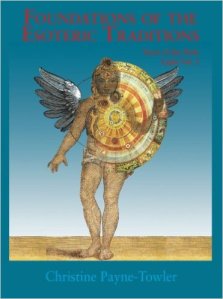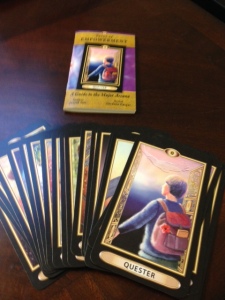Foundations of the Esoteric Tradition:
Tarot of the Holy Light
Vol 2
Author: Christine Payne-Towler
Senior Editor: Michael Dowers
Associate Editor: Christine Payne-Towler
Cover: Michael Dowers (Note: This is a provisional cover.)
Noreah/Brownfield Press
2016
ISBN # 978-0-9673043-4-2
Dedication
In honor of,
in answer to,
in anticipation of
the world community of Tarot.
With thanks to Sophia at every step.
I have been a fan of Christine Payne-Towler’s work since it first crossed my radar. I recently had the chance to meet Christine in person, and she is a very down to earth, knowledgeable individual, with a great sense of humor. Her works include: The Underground Stream: Esoteric Tarot Revealed, The Tarot of the Holy Light (deck), and The Tarot of the Holy Light (Vol 1 – companion book). Where Tarot of the Holy Light (Vol 1) is the user’s manual for the deck, demonstrating the traditional assumptions built into the outline of the classical Tarots of continental Europe, the 296 page Foundations of the Esoteric Tradition: Tarot of the Holy Light Vol 2 deals with the esoteric background of this deck, and how to put these cards truly to work in your life. It traces the historical references that support Western Esotericism per se. It also helps the reader to put the Continental tradition, and its Alpha-Astro- Numeric (AAN) foundation, to work in an individual’s life.
In the beginning of the book is a list of illustrations, chapter by chapter, followed by Tarot deck citations. In his preface, Angel Lozada talks about reading Payne-Towler’s Underground Stream, followed by an in-depth interpretation of his astrological chart with her. A friendship formed, and he began studying the traditions of Tarot with her. He notes that in working with the correspondences associated with the Tarot, Payne-Towler takes into consideration the Continental traditions that are often overlooked, and sometimes rejected. He sees her emphasis on influences from the Spanish Portuguese schools, as well as contributions from Protestant Masons.
In her introduction, Payne-Towler starts out by noting that the Tarot is esoteric by its structured and numbered categories. It can be used as a magical calculation tool in the absence of astronomical tables and special knowledge. She states that we need to keep in mind that the Church had a powerful hold on the transmission of metaphysical and theological subjects. We must work backwards through existing materials to define the root ideas of Tarot they were originally. What we see now is a series of clichés that serve to obscure the original template of the Tarot.
The discussion moves on to Jacob Boehme (1575-1624), a philosopher who lived in Bohemia. His works inspired esoteric groups such as the Rosicrucians, the Masons and the Martinists. The discussion of his work, and the influence it had on the esoteric structure of the Tarot, is incredible! Immense research has been done here – research that could act as the starting point for any student’s research. You have to be able to think to understand what is being presented – once you start thinking, the world opens up! One sentence stands out: “Tarot of the Holy Light is about the search for the precedents of Tarot’s unique outline, an experiment in thinking the way our illuminated ancestors did.” Payne-Towler also notes that all of the sources that she cites work within the Continental magical assumptions. The reader is gifted with the foundation that Payne-Tower comes from personally. I loved this section, because it states in no uncertain terms what she will and will not accept in working with the Tarot, its esoteric base, and its traditions. Her stated aim is to clarify core issues, and to understand the logic behind the intersection of Astrology, Alchemy, and Kabbalah.
Chapter 1 – Clairvoyance and Apprehending the Cosmic Body sets the stage, addressing the essential quality at the foundation of all esoteric traditions. It is this quality of magical imagination that is found in historical magi of every age. It is all about knowing your own energy body.
Chapter 2 – The Hermetic Cosmos talks about the mathematical matrix of Ancient Astrology, which Payne-Towler notes is the root source for the working vocabulary of the Western Mysteries. Here we get into the importance of birth charts, and how the planets as they transit our chart affect our lives. From the book: The specific goal of a Tarot Magus is to front-load the cards with these astral values so we can read our Tarot spreads at the greatest number of levels, granting us the most holistic insight into ourselves, our powers, and our times.
Aside: Payne-Towler did a very magical series of classes based on Foundations of the Esoteric Tradition that, in part, reviewed individual class members charts, showing how an individual can use the movement of the planets to help them understand what is going on in their life.
Chapter 3 – The Alphanumeric Doctrine of Correspondences shows how our modern alphabet was influenced by ancient astronomers to carry numeric and astrological data within each letter. This presents a philosophical foundation for both the Hermetic philosophy and the Kabbalah.
Chapter 4 – The Kabbalistic Alchemists recounts the growth of Kabbalistic thought among the magical Christians of the Middle Ages and the Renaissance. In this chapter the reader is introduced to the magic of the Tarot of Holy Light icon (which can be downloaded from Payne-Towler’s site (http://www.tarotuniversity.com/) , so that the reader can construct their personal chart in Tarot terms.
Chapter 5 The Cosmos In The Tarot discusses the interlocking traditions of the Tarot in a visual manner. In the Pips we see the development of the Alchemical implications of the Doctrine of Essential Dignities.
Chapter 6 The Seven Planetary Properties talks about Jacob Boehme’s insight into the Planetary Properties, showing their esoteric and theological fundamentals. We also see the alchemical interrelations of Astrology as they are projected onto The Kabbalah Tree, analyzing the astral body of the practitioner.
Chapter 7 Yoga of the Restitution examines the worldview and lifestyle associated with Jacob Boehme’s “Yoga of the Restitution”, complete with illustrations created by Boehme’s students. This is incredible artwork!
Chapter 8 Theosophic Spirituality or The Alchemy of the Restitution notes that the root to Boehme’s basic approach and vocabulary were adapted from the Agrippan synthesis, specifically the astro-healing model. This material was taken up by the Rosicrucian and Masonic movements that followed. It is also interesting to note Boehme’s insistence on the development of visionary skills.
At the end of the book there is a bibliography and an index – both of which are helpful as a foundation for further study.
This is a phenomenal book, going deeply into the esoteric nature of the Tarot. It is well written, well sourced, and very easy to follow. Each time you re-read a section in this book, you will come away with more information. And, whether you agree with it or not, you will come to an understanding of the traditions behind the Continental system of Tarot. It is a wonderful companion to Vol 1 – Tarot of the Holy Light: A Continental Esoteric Tarot. It is a gift to find all of this information gathered in one place! And … Payne-Towler is generous with charts and images – visual cues to understanding this material.
© March 2016 Bonnie Cehovet
Reproduction prohbited without written















